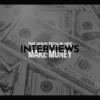Alright, buckle up because we’re diving into “100M.” This isn’t about running sprints. We’re hitting that sweet $100 million mark, a huge milestone in business. Think of it as reaching level 100 in your favorite RPG. Instead of slaying dragons, you slay business goals.
The Gospel of Hormozi: Decoding the 100M Playbook
If you’re curious about cracking the “100M” code, you’ve likely heard of Alex Hormozi. He offers real financial advice from experience. He’s an entrepreneur, investor, and author with a net worth near $100 million (2025). You may have seen him on YouTube or Instagram, inspiring many to leave their 9-to-5s.
Hormozi has the credentials to back his hype. Magna Cum Laude graduate from Vanderbilt University in three years? Check. Major in Human & Organizational Development? Right for someone who scales businesses. Sold 66% of Gym Launch & Prestige Labs for $46.2M? Just another day for him. So when Hormozi shares advice, he’s speaking from experience.
The Bibles of Business: “$100M Offers” and “$100M Leads”
Hormozi shares his wisdom in two must-read books: “$100M Offers: How to Make Offers So Good People Feel Stupid Saying No” and “$100M Leads.” These are not typical business books filled with fluff. They provide practical strategies. They are the CliffsNotes to building a business empire.
“$100M Offers”: The Art of Irresistibility
Let’s start with “$100M Offers.” The book is clear: it teaches you how to create offers that people cannot refuse. These offers don’t just appeal; they compel customers to say “yes.” They feel like they are getting away with something while happily spending their cash.
In “$100M Offers,” Hormozi provides strategies to craft these offers. It’s not just about discounts or free gifts. It’s about understanding human desire and creating value. This book focuses on psychology and value creation. Clearly, it resonates. Hormozi’s books have sold over 1,000,000 copies worldwide. A lot of people want offers so good it should be illegal.
If you’re concerned about length, “$100M Offers” has 164 pages in hardcover. The print version is around 258 pages. Fast readers could finish it in about 2 hours. Faster than a Marvel movie, and likely more valuable.
“$100M Leads”: Fueling the Machine
An amazing offer is great, but it’s useless without leads. This is where “$100M Leads” comes in. This book focuses on pumping leads into your business. It fills your sales funnel with prospects eager for what you sell.
In “$100M Leads,” Hormozi discusses lead generation in detail. He provides practical tactics and shows how to craft a lead magnet. He teaches cold outreach without sounding desperate. You’ll learn how to build an engaged audience and scale advertising. You can even set up an affiliate program to have others promote you. It ensures your offer reaches those who need it.
If you like to learn while multitasking, listen to the “$100M Leads” Audiobook for free. Hormozi shares valuable knowledge at no cost. Don’t miss out.
Crafting the Million-Dollar (and Beyond) Offer: The Secret Sauce
What’s the secret behind “100M Offers”? It’s a balance of four key ingredients. Imagine baking a cake, but with psychological levers instead of flour. Here’s the recipe.
You need to boost the Dream Outcome and Perceived Likelihood of Achievement. These factors are what makes people excited. What’s the ultimate fantasy your customer wants? Make it vivid. Then show them you’re the expert who can guide them there.
On the flip side, minimize the Perceived Time Delay and Perceived Effort and Sacrifice. These are your tools for overcoming objections. Nobody wants to wait forever for results or struggle hard. Shorten their timeline to success and simplify the path. The less hassle they perceive, the faster they’ll pay.
Get this right, and you can create offers that not only convert but also build a loyal customer base who feels they hit the jackpot.
The $100 Million Revenue Milestone: A Sign of True Grit
Now, let’s focus on $100 million in revenue, especially Annual Recurring Revenue (ARR). Achieving $100 million ARR isn’t just good news; it indicates serious growth. In the startup world, ARR is vital, and $100 million ARR is a royal status. It signifies a business that’s sustainable and consistent, attracting investors.
The number of employees in a $100 million ARR company has changed over time. Previously, these companies had about 100 employees. Nowadays, with Unicorns raising funds, that number is often closer to 1000. More funding means more growth, requiring more staff.
The Financial Hierarchy: From Millionaires to Centimillionaires
Now, let’s understand the “$100 million” figure within the wealth landscape. It turns out, $100 million is not just “rich”; it’s “ultra-rich.” Firms like BCG use a strict definition for “Ultra High Net Worth” (UHNW). To be classified as UHNW, you need more than $100 million in liquid wealth. We’re discussing cash and easy-to-access investments, not your home’s value or collectibles. This threshold is above the “normal” ultra-rich definition of $30 million established in 2007. Thus, $100 million is truly “ultra-ultra-rich.”
If $100 million feels distant to you, let’s…
let’s examine some more “achievable” milestones. To attain “very high net worth” status, net worth should sit around $5 million to $10 million. It’s still elite, yet more realistic for some. Dreaming of the $3 million club? A very exclusive financial area, representing less than 1% of retirees. Hitting even $3 million is impressive.
The Centimillionaire Surge: A Growing Elite
Now back to the $100 million benchmark. Individuals with investable assets of at least $100 million are “centi-millionaires.” Guess what? Their numbers are rising. In 2023, the centi-millionaire club grew to 28,420 people globally. This is double the number from two decades ago. The rich are getting richer; their ranks are increasing.
Where do these centi-millionaires gather? The U.S. stands as the clear leader in entrepreneurship and centi-millionaires. Reports claim that 38% of the global population worth $100 million or more live in the U.S. America remains a land of opportunity, especially for those aiming high on the wealth ladder.
If you think the $100 million crowd is large, check out the $50 million group. In 2020, the U.S. counted 110,850 individuals with net assets over $50 million. That’s a significant number of very wealthy individuals.
The Road to Millions: Practical Steps (and a Dose of Reality)
Let’s set aside massive wealth figures. It’s time to talk about how ordinary people can start their financial journey, even if $100 million seems unreachable. The path to millions isn’t paved with lottery wins or get-rich-quick schemes. It requires consistent, smart choices and discipline.
Here’s a straightforward checklist for making financial progress:
- Control Your Expenses: This is Financial Literacy 101 and essential. Stop wasting money on unnecessary items. Track spending, spot leaks, and fix them. Every dollar saved is an investment opportunity.
- Start Retirement Contributions Early: The compounding effect is real. The sooner you begin saving for retirement, the more time it has to multiply. Even small, consistent investments can grow significantly over decades.
- Become Tax Savvy: Know taxes but manage them wisely. Understand tax-advantaged accounts, deductions, and credits. Don’t allow Uncle Sam to take more than necessary.
- Invest in Real Estate: Real estate often serves as a solid wealth-building asset. Rental properties, house flipping, or owning your residence can enhance your financial strategy.
- Diversify Your Income: Relying on one stream of income is risky. Consider side gigs, freelance work, or investments for multiple income sources. This boosts earnings and creates a safety net.
From $250k to $1 Million: The Power of Consistent Growth
Let’s get specific now. Say you’ve saved up $250,000. How do you transform that into $1 million? It’s not about a lucky win overnight. It’s about consistent investing and achieving returns over time.
If you invest that $250,000 in growth-oriented assets like stocks or real estate, compounding works wonders. While it’s not an overnight riches scheme, with patience and smart choices, your $250,000 could realistically grow to $1 million.
Living the Dream: Making $1 Million Last
You’ve reached the $1 million mark. What’s next? Can you live off $1 million? The answer is “maybe.” It hinges on lifestyle choices, spending habits, and strategies.
The “4% rule” indicates that withdrawing 4% of retirement savings yearly can sustain you for 30 years. For a $1 million portfolio, this suggests withdrawing around $40,000 in year one. That’s a good amount, but you must account for expenses, taxes, and if $40,000 fits your lifestyle. Living on $1 million is feasible with planning.
The $1,000 a Day Hustle: Los Angeles Edition
If you’re still earning, let’s discuss making serious income daily. Is earning $1,000 possible in one day? In Los Angeles, CA, where costs are high, it’s definitely within reach with effort, skills, and maybe luck.
Here are options to consider for the $1,000-a-day target:
- Freelancing: If you possess in-demand skills like writing or coding, you can charge high rates for freelance work. A good project could deliver over $1,000 in one day.
- Gig Work: Most gig jobs won’t yield daily $1K consistently. However, strategic gig work in specialized fields could lead to higher earnings.
- Day Trading/Investing: This is high-risk territory. If skilled and knowledgeable, a day of successful trading might yield $1,000 or more but also risks losses.
- High-Demand Services: Provide valuable services in demand for premium rates. Examples include personal training or specialized consulting.
Earning $1,000 daily demands effort, skill, and determination but is a worthy goal.
Business Valuation: What’s Your $3 Million Sales Business Worth?
Let’s discuss business valuation for those with a business generating $3 million in sales. You might wonder about its worth. The answer varies based on many factors like industry and profit margins.
For businesses under $3 million in revenue, typically they sell for 2.5 to 3.5 times their discretionary earnings. But this only provides a rough guideline. High-growth tech startups often fetch higher multiples than traditional stores with slim profits.
So there it is – a whirlwind journey through the “100M” world, from Hormozi’s insights to building wealth and valuing businesses. Building wealth requires intelligence, effort, and boldness. After all, who achieves greatness by playing it safe?





